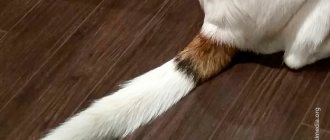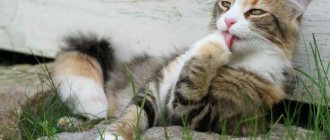7289Pavel
The tail is the most mobile part of a cat's body. There are many reasons why a cat shakes its tail. This is explained by the fact that dozens of vertebrae are involved, thanks to which the animal’s behavior can be used to learn about the pet’s mood, feelings and condition.
In most cases, a cat's tail is a way to express emotions, which means it is a way to find out what the pet is experiencing in a given situation. This is influenced by the situation, the direction of movement: the pet’s feelings are not always positive.
© shutterstock
The cat shakes its tail to express:
- Satisfaction . If the animal is satisfied with what is happening, simply happy and rejoicing, the tip of the tail twitches slightly. Satisfaction is accompanied by purring. The pet owner has nothing to worry about, but can only enjoy the cat’s affection.
- Interest . A curious cat shows its interest not only by closely observing a certain place or object. The tail moves evenly and slowly. The general state is assessed as relaxed and focused. A typical situation is when the owner returns from work with a bag of treats when the pet is already waiting at the door.
- Anxiety . If the animal is tense, frightened and wary, the tail moves in a horizontal direction. This is a condition in which the cat is not only defending itself, but is also ready to attack. A striking example is hunting for prey, when the cat's ears are flattened and the tail is constantly moving horizontally.
- Doubt . The problem of choice was transmitted to domestic cats from people. At the same time, the tail shakes chaotically in different directions, but there are no other emotions either on the face or in the body. This means that the pet does not know what to do and is waiting for a signal from the owner, who will give a kind of “answer” to the question.
How cats communicate using their tail
In a cat society, the tail is simply irreplaceable. With the help of this part of the body, cats can express their attitude towards each other without uttering a sound.
Serious cat
The cat twitches its tail, and it is raised by a “pipe”
This is how the cat expresses pride in himself and his appearance. The cat feels confident in the circle of those present. Or the pet is very happy about the long-awaited meeting with the owners.
For your information! Showing self-confidence, cats can lick in front of unfamiliar animals and people.
The tip of the tail moves from side to side
This is how the animal shows curiosity, keen interest and some apprehension. This is usually how cats behave when meeting a new resident of the house.
Important! At the moment when the cat is excited, he is easily scared. Therefore, owners need to be careful not to frighten their pet. It is necessary to calm the kitten: pet it, scratch it.
If a cat looks around in fear and shakes its hooked tail, then something or someone is irritating it. Perhaps this is how the pussy tells its owner or pet that it does not intend to play or is not in the mood to communicate.
The fur on the tail is ruffled
In this situation, the cat is preparing to attack unexpectedly, so owners need to be vigilant. Perhaps, in this way, the cat is honing its hunting skills through play, or the pet is very irritated.
Annoyed cat
Tail as sign language
If a cat raises its tail and shakes it, this gives an idea of more than just the condition of the pet. In this way, the furry animal expresses emotions during communication and lets the owner know what he wants and what he is ready for :
- When the animal is in a playful mood, the tail stands upright and twitches slightly. However, if the cat hits it on the floor, you should understand: the pet is irritated and no longer wants to continue the game.
- The cat's nervous irritation is indicated by a vertically raised tail like a pipe, but curved at the tip. In this state, it is better not to touch the pet: a blow with a paw with extended claws is a predictable reaction.
- If a cat sits, meows and makes small movements with its tail, this also indicates stress. But this may also be a consequence of pain, discomfort on the body or in the body.
- An angry cat is the easiest to identify. Rising fur, hissing and purring, as well as a sharply twitching tail, means that the predator is ready to attack and will respond to any awkward movement in its direction.
© shutterstock
Why do cats shake their tail?
Watching the cat, breeders wonder why the cat develops new behavioral characteristics - the tail is shaking. To give an accurate answer, you need to understand the details of this phenomenon.
The cat is coughing: why it wheezes, the reasons, as if it was choking
A restless cat holds his tail in a horizontal position. If a cat's tail occasionally trembles and he looks around in fear, with his ears pressed to his head, this indicates the animal's alertness. If there is an object of irritation in the room, then it should be removed from the cat’s field of view, otherwise the animal may panic, and the further outcome of the actions of a frightened animal is unpredictable.
Note! But if the tail sways from side to side, you need to be prepared for a sudden attack by your pet, however, such a command from a pet does not always foreshadow a threat. Similar habits can be observed while playing with an inanimate object. Cats, parading their ancestors, attack their toy.
Cats, like humans, can express doubt when they need to make a choice. Living for several thousand years side by side with people, the descendants of tigers began to adopt some of the habits of the supreme being. While in thought, a person can rhythmically tap his fingers on the table or swing his leg. Likewise, a cat, which is faced with a choice, begins to involuntarily twitch the tip of its tail; the pussy holds the base of the tail straight. Moreover, in such a situation, only the tail is involved, that is, no other peculiarities in the cat’s behavior are observed. To stop flinching, you just need to help your pet make a choice.
The cat also twitches its tail, expressing a feeling of satisfaction. When the cat is calm, fed, and happy, he slowly raises the tip of his tail up and down. Also, such behavior indicates reciprocal feelings for the owner’s affection, so a representative of the cat family expresses gratitude to a person, and the cat purrs and, perhaps, rubs against the owner’s hands, walks around the owner. In addition, by twitching its tail, the cat informs others that what is happening in the room completely satisfies it.
Often the reason for a wagging tail is interest. Movements of the tail are carried out slowly and to the beat, but the general appearance of the animal remains unchanged, all the cat’s attention is focused on one object. This usually happens after the owner goes to the store; in such a situation, the subject of the cat’s examination becomes a bag of food. A pet, showing interest in something, watches with caution, sniffs, carefully examines the object, sometimes engrossed in its occupation, and prevents the owner from passing.
Note! To accurately determine why your beloved cat's tail is shaking, you need to be attentive to details, namely, the environment in which the animal is located, the general appearance of the cat and the pet's surroundings at the moment.
Why does a cat twitch its tail?
To achieve complete mutual understanding with your beloved cat, you must carefully observe the animal. Over the millennia spent next to humans, cats have learned to communicate with them in sign language. They signal their mood using various parts of their body, the most eloquent of which is its tail. A cat twitches its tail when it wants to tell its owner that it is hurt, scared or lonely. Often twitching indicates an incurable disease of the animal. Therefore, cat owners should know well what the pet’s various body movements mean and why he makes them. This will help to identify and fix the problem in time.
The cat is shaking its tail: what is its mood?
Why is the kitten shaking as if he is cold?
Like people, cats have a body language that can be used to determine the animal’s state of mind. So, the owner, by looking at the cat, can understand whether the cat wants to play, or whether it is better to leave the pet alone.
- If a cat intends to play with a person, he expresses this with a slight twitch of his tail directed vertically upward. If during play the cat begins to loudly lash the floor with its tail, then everything should be stopped.
- A pet's irritation can be easily determined by the nervous twitching of its tail in different directions. Sometimes an indicator of an irritated state is a tail raised up, with its tip bent in a hook.
- Another reason for tail shaking is a feeling of stress, some fear. Your pet may be experiencing pain. If a cat is worried about something, it usually taps its tail on the floor with small shot, and the general appearance of the animal is full of thoughtfulness. To eliminate the possibility of your pet becoming ill, it is necessary to examine the animal as soon as possible and take appropriate measures.
- If the fur on the cat's back is tousled and the tail flicks from side to side, you must be careful and attentive when interacting with your pet, as the animal may suddenly attack.
What other reasons for movement are there?
Tail movements indicate not only the mood of the pet, but also the state of its health. If the cat's behavior is unusual, you need to examine the animal and observe it.
If a cat shakes its tail, it means it is “speaking” and wants to be understood. There are a number of common “phrases” that are expressed by moving the tail:
Regularly repeated movements of this part of the body must be understood and carried out by the owner of what the furry is asking him to do.
- Playful mood - the tail is raised vertically and twitches easily.
- Irritation, reluctance to play anymore - the tail hits the floor.
- Nervousness, warning of a possible attack - the tail is raised, but its tip is bent.
- Stress - the cat's tail trembles when in a calm mood and meows. An animal may behave this way when sitting or lying down. In addition to emotions, this indicates pain and general malaise of the pet.
- An extreme degree of irritation, a harbinger of an attack - the tail is lowered and twitching, the animal purrs gutturally, the fur stands up.
Chaotic tail shaking can be a sign of serious illness in your pet. If, in addition to trembling of an incomprehensible nature, twitching of the hind legs is noted, you should consult a veterinarian. Common causes of this phenomenon are considered to be stressful situations, pinched nerve endings, and inflammation of the anal gland. Sometimes this is due to the discomfort caused by parasites or inflammatory formations that have arisen.
The cat's tail and skin on its back twitch - why and what does this mean?
Cat owners sometimes observe the following picture: the pet's tail twitches, as if he is marking territory, and the skin on his back shakes, as if he is trembling in this particular part of the body. This phenomenon may have physiological and pathological causes. Regardless of what exactly led to the twitching of the tail and skin, the four-legged pet in this situation requires the help of the owner.
The animal has fleas or other ectoparasites
If an adult cat or kitten twitches its tail, while the skin on its back trembles, it may be overcome by ectoparasites (those that parasitize not under the skin, but on its surface): fleas, lice eaters, ticks. In addition to these symptoms, external parasites manifest themselves as follows:
- bite marks on the body in the form of small red dots;
- unbearable itching in the affected areas;
- constant scratching in an attempt to somehow relieve the itching from the bites;
- jumping black dots, grains that look like dirt;
- deterioration of the coat (loss, loss of shine, fragility);
- sleep disturbance – due to constant itching, the cat hardly sleeps;
- complete or partial lack of appetite;
- anxiety, lack of interest in games, apathy;
- ulceration of the affected skin, scabs;
- reduction in body weight.
Having discovered ectoparasites in your pet, you must immediately begin treatment. Ignoring the fact of their parasitism on the cat’s body is fraught with serious consequences for his health.
The cat is nervous
Is your pet shaking its tail? This may be a sign of anxiety. Don't confuse anxiety with stress. Both of these conditions are associated with negative emotions, but in the first case they are not as pronounced as in the second. Anything can cause anxiety in a cat. She may get nervous because of a large crowd of people in the house, the appearance of a stranger in it, the long absence of the owner, etc.
In order for the pet to calm down, you need to pick it up, caress it, and talk to it. It is best to try to switch the animal's attention to something else, such as a game. By spending time actively and having fun, it will forget about worries.
Pet wants to go to the toilet
If an animal's back twitches closer to its tail, it most likely wants to go to the toilet. Observing cats, you can notice that their skin in this area begins to tremble before bowel movement occurs. This is normal.
This situation requires the intervention of the owner if the trembling does not end with defecation, and the pet becomes restless, meows pitifully, and refuses to eat. This behavior indicates constipation. If your four-legged pet does not defecate for several days in a row, it is time to take measures to empty its intestines of feces.
The cat was bitten by an insect on the back or tail (mosquito, wasp, etc.)
Is your pet twitching its tail, the skin on its back shaking, while it is worried about something or meowing pitifully? Perhaps he was bitten in this place by a wasp, bee, mosquito or horsefly. To help your pet cope with itching and pain, you must first make sure that there is no insect sting left at the site of the bite. If it is detected, you need to carefully remove the foreign body with disinfected tweezers.
Wasp and bee stings are not as harmless as they might seem at first glance. Its danger is that the cat may develop an allergic reaction to bee and wasp saliva. If you discover that your cat has been bitten by an insect, you need to give him an antihistamine and carefully monitor his condition. If suspicious symptoms appear, the pet should be taken to the nearest veterinary hospital as quickly as possible. To eliminate pain and itching, you need to anoint the bite site with antipruritic ointment.
The cat's back itches due to allergies
This problem may be caused by an allergic reaction. Allergies in cats can be caused by pollen from flowering plants, dust, the owner's perfume, food, medications, substances secreted by ectoparasites, litter for the litter box, etc. The increased sensitivity of the cat's body to allergens is manifested by a number of symptoms common to all irritants:
- skin rashes;
- deterioration of hair condition (loss, fragility);
- unbearable itching;
- bloody wounds due to scratching;
- nasal congestion;
- copious clear nasal discharge;
- sneeze;
- excessive salivation;
- peeling of the paws, especially in the areas between the toes;
- breathing problems;
- indigestion.
Allergies are not as harmless as they might seem. An allergic reaction can lead to a fatal condition - anaphylactic shock. To prevent this from happening, you need to start eliminating the problem immediately after the listed symptoms appear in your pet.
So why do cats need tails?
1. Tails help us cats maintain balance when, for example, we walk along some thin perch or sneak along a fence. You've probably already noticed that when cats find themselves in a similar situation, they begin to wag their tail to gain balance.
2. With the help of our tails, we show our other relatives and you people what mood we are in.
Mood #1 “Peace, I love you!” - the tail is a pipe, and there is calmness on the face;
Attitude #2: “You’re finished! War is inevitable! - the tail sticks out like a “pipe”, and the fur all over the tail stands on end;
Mood No. 3 “Hide, everyone!” This mindset is essentially similar to mindset #2. Only in this case, we swing our tail from side to side, with increasing speed, and even hit ourselves with our tail on our own sides.
Mindset #4: “What should I do? What do i do?" - the tail is lowered, and the fur is ruffled only at its base, this indicates that the cat has encountered something unexpected, or is slightly frightened, and cannot decide what to do next;
Mood No. 5 “What a nightmare! It's time to get out!" - the tail is lowered down, and all the fur on it stands on end;
Mood No. 6 “Go away, old lady, I’m in thought.” The cat's back is relaxed, the tail is also relaxed, and its tip swings slightly from side to side. This means that the cat is trying to choose one of two possible options in a given situation;
Attitude No. 7 “I’m already starting to get tired of this!” - if we cats randomly swing our tail from side to side, without setting a rhythm to the movements.
I hope now you understand why cats need tails.
Part 3.
Do you know what cat tails are?
There are different tails: green, white, red! - Joke.
In fact, there are even cats that have almost no tails. And I say this quite seriously. Owners of such tails are, for example, Kurilian bobtails, Japanese bobtails, Japanese mi-kei cats, British Manx cats and some other “lucky” ones.
Why do they have short tails? There are a huge number of beautiful legends about this. But since I’m a serious cat, I’ll start with a scientific theory: short cat tails appeared as a result of a genetic mutation in cats that lived on the same island and did not have the opportunity to “fall in love” with cats of a different blood and origin, i.e. from other “families” and “clans”.
Now let's get to the legends:
According to the first legend, “short-tailed” cats appeared during the time of Noah’s Ark. Noah, in a hurry, cut off the tail of one long-tailed cat with a door, which was too slow to climb into his ark.
But according to the second legend, cats living on a separate island became very close “friends” with female rabbits, and from this “friendship” kittens with tiny tails began to appear there.
According to the third, the most cruel and bloody legend, the ancient Vikings considered cat tails to be excellent talismans against death in battle, so they cut off the cats' tails and carried them with them as amulets. When loving cat mothers found out about this, they began to bite off their kittens’ tails themselves so that the Vikings would not be interested in them.
I don’t know about you, but I prefer the scientific theory, since it is more or less humane.
Yours, Jose Carreras, with love! La-mur-mur.ru.
PS: My tail is 24 centimeters long! How long is your cat's tail? Be sure to show off “your” tail in the comments to this article.
The tail is the most mobile part of a cat's body. There are many reasons why a cat shakes its tail. This is explained by the fact that dozens of vertebrae are involved, thanks to which the animal’s behavior can be used to learn about the pet’s mood, feelings and condition.
In most cases, a cat's tail is a way to express emotions, which means it is a way to find out what the pet is experiencing in a given situation. This is influenced by the situation, the direction of movement: the pet’s feelings are not always positive.
The cat shakes its tail to express
:
- Satisfaction
. If the animal is satisfied with what is happening, simply happy and rejoicing, the tip of the tail twitches slightly. Satisfaction is accompanied by purring. The pet owner has nothing to worry about, but can only enjoy the cat’s affection. - Interest
. A curious cat shows its interest not only by closely observing a certain place or object. The tail moves evenly and slowly. The general state is assessed as relaxed and focused. A typical situation is when the owner returns from work with a bag of treats when the pet is already waiting at the door. - Anxiety
. If the animal is tense, frightened and wary, the tail moves in a horizontal direction. This is a condition in which the cat is not only defending itself, but is also ready to attack. A striking example is hunting for prey, when the cat's ears are flattened and the tail is constantly moving horizontally. - Doubt
. The problem of choice was transmitted to domestic cats from people. At the same time, the tail shakes chaotically in different directions, but there are no other emotions either on the face or in the body. This means that the pet does not know what to do and is waiting for a signal from the owner, who will give a kind of “answer” to the question.
How cats show their mood
A cat's tail consists of many vertebrae and performs a large number of functions. The main role is balancing during movement and hunting. But a cat's tail is also an expression of her behavior and character. This means that if the owner is attentive and loving, then it will be easy for him to determine the cat’s mood by the tail. It is when and how a cat shakes its tail that you can understand what mood it is in.
A cat's tail twitches in different ways - both vertically and horizontally. To figure out how to understand a cat by its tail, you need to take into account many factors. These may include:
- people unfamiliar and incomprehensible to them. For older cats, this can be a stressful environment. And if this is a cat with kittens, then the trembling tail will immediately let you understand displeasure and fear for its offspring;
- general situation in the breeder’s family. If you constantly scream and at the same time can periodically hit the kitten, you should be prepared for the fact that the cat arches its back and its tail is fluffed or tucked. But when you love and cherish your pet, then his tail will almost always be a pipe, and the threat of an arched back and hissing sounds will bypass you;
- If an animal beats its tail, meows, shakes, its pupils are dilated and it tucks or arches its tail, then the pet is letting you know that it is experiencing fear. In such a situation, it is better to remove the object that provoked panic;
- An unfamiliar environment or moving can also cause displeasure in the pet, which will be expressed in the fact that the cat jerks its fifth limb. Let her know that you are looking out for her and want the best for her.
Why do cats need a tail?
Roughly speaking, the tail ends the spine of representatives of the cat family. It is a collection of vertebrae, blood vessels and nerve endings, due to the large number of which this part of the body in cats is especially weak and sensitive to touch and can easily be injured by abuse. This is why animals don't like it when someone tries to touch their tail, or, even worse, pull it.
Thanks to the presence of a tail, cats maintain coordination of movements, moving along narrow surfaces and jumping from heights, and also have excellent spatial orientation, deftly and quickly climb to the tops of trees, and successfully track down small animals.
But the main thing for the owner is that by watching how the pet wags its tail, he can recognize the mood and even unravel the pet’s plans. By learning what a cat's tail wags means, you will be able to understand the animal, maintain a trusting relationship with it, and respond correctly to its wishes.











